Crickhowell is a town and community situated in the south-eastern part of Breconshire, near Abergavenny, and lies on the River Usk. The community sits on the southern edge of the Black Mountains and in the eastern part of the Brecon Beacons National Park and significant parts of the surrounding countryside form part of the Glanusk Park estate. The men of Crickhowell and the surrounding villages who fell during both World Wars are commemorated on a relatively modern war memorial, which is situated near the site of the Crickhowell War Memorial Hospital, besides the A40 road. The memorial also commemorates one local man who was killed during the Iraq War. I have split the war memorial up into its separate villages: Crickhowell; Cwmdu; Llanbedr; Llanelly Hill; Clydach, Gilwern; Llangattock; Llangenny; Llangynidr; and Patrishow. The original war memorial, in the form of a wooden memorial board was situated inside the Crickhowell War Memorial Hospital. He hospital was opened on 12 June 1920 in a ceremony attended by Lord Glanusk, and the memorial was dedicated by Reverend George Roberts, Rector of Crickhowell.
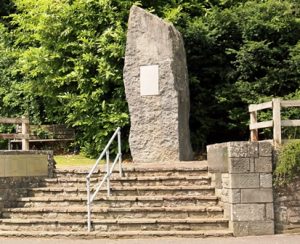
The Great War, 1914-1918
Godfrey Horace Beavis, Private, 2138298, Canadian Infantry. Godfrey was born at Crickhowell on 29 July 1888, the son of Edward Samuel Beavis and Clara Emily Beavis (nee Perrott). His parents died in 1901 and young Godfrey emigrated to Canada at some time afterwards. Godfrey found work as a clerk and lodged at Morrison Mansions, Corner Chester and Hilda, Victoria, British Columbia. He enlisted into the 2nd British Columbian Regiment at Victoria on 14 January 1918. Godfrey embarked for England at Halifax aboard the SS Scotian and disembarked at Liverpool on 28 April 1918, before entraining for Seaford. On 14 August 1918 Godfrey was drafted to France, joining the 72nd Battalion, Canadian Infantry, which was attached to the 12th Infantry Brigade, 4th Canadian Division. Godfrey joined the battalion as it was taking part in the great advance to the Hindenburg Line. He was killed by enemy shellfire whilst in the front line at Hendecourt-les-Ransart on 29 September 1918. The 30-year-old has no known grave and is commemorated on the Vimy Memorial, France.
Edwin James Blacker, Corporal, 7586, King’s Shropshire Light Infantry. Edwin was born at Abergavenny on 9 August 1881, the son of James Edwin Blacker and Selina Blacker (nee Morgan). The family had moved to the Baptist Chapel Cottage, Crickhowell by 1891. Edwin moved to Abergavenny as a young man and worked there as a decorator. He enlisted into the Imperial Yeomanry in Cardiff on 5 March 1901 and embarked for South Africa on 22 March 1901 to join the 4th Company, 1st Battalion, Imperial Yeomanry. Edwin took part in the latter stages of the Boer War, gaining the clasps Cape Colony, Orange Free State and Transvaal to the Boer War Medal, and returned to Britain on 27 August 1902. He married Elizabeth Matthews at Llangynwyd on 16 September 1903 and the couple set up home at 1, Hop Bine Place, Commercial Road, Hereford where Edwin resumed worked as a decorator. As a former soldier, Edwin was an Army Reservist when the Great War broke out and he enlisted at Hereford into the King’s Shropshire Light Infantry. He embarked for France on 18 February 1915, joining the 2nd Battalion, King’s Shropshire Light Infantry, which was attached to 80 Brigade, 27th Division. Edwin fought with the battalion during the Action of St Eloi, and at The Second Battle of Ypres soon afterwards. He was probably wounded at some time and returned to Britain, before embarking for France again, joining the 7th Battalion, King’s Shropshire Light Infantry. The battalion was attached to 8 Brigade, 3rd Division by the time that Edwin joined its ranks. Edwin would probably have fought with the battalion on the Somme in the summer of 1916, at the Battle of Bazentin, where it captured Longueval. The Division then took part in the Battle of Delville Wood, and the Battle of the Ancre, before settling into a bleak winter in France. In May 1917 the Division was at Arras and took part in the First and Second Battles of the Scarpe, and then in the Battle of Arleux and the Third Battle of the Scarpe, where it captured Roeux. The Division then moved north to Ypres and saw further fighting during the Battle of the Menin Road and the Battle of Polygon Wood. In November the Division moved south again and fought at the Battle of Cambrai. On 26 December 1917 the 7th KSLI relieved the 8th Bedford’s in the front-line at Mory to begin a routine tour which would see the men celebrate Christmas in the trenches. Edwin was badly wounded here during this spell and died of his wounds on 26 December 1917. The 36-year-old is buried in Mory Abbey Military Cemetery, Mory, France.
William Walters Colerick, Private, 2034, Monmouthshire Regiment. William was born at Abergavenny on 22 January 1895, the son of William Colerick and Florence Evelyn Colerick (nee Walters). The family later resided at Castle Road, Crickhowell. William worked as a newspaper’s assistant prior to enlisting into the 3rd (Reserve) Battalion, Monmouthshire Regiment on 29 August 1914. William was discharged from the regiment as medically unfit on 1 January 1915. Undeterred, he enlisted into the Royal Naval Volunteer Reserve on 11 December 1915. He was posted to the 4th Reserve Battalion, Royal Naval Division at Blandford for training, before taking ill and was hospitalised in the Royal Naval Hospital at Portland. William was found to have contracted tuberculosis, so was discharged from the Royal Naval Division in May 1917. He then re-enlisted into the Monmouthshire Regiment again and served on home service until after the Armistice. William was discharged from the army in the spring of 1919, and returned home, but his health continued to wane, and he died of tuberculosis on 6 July 1919. The 24-year-old was buried in St. Edmund’s Church, Crickhowell along with his father, who had been tragically killed on the previous day whilst attempting to start his motor lorry. William is not commemorated by the CWGC and is also not commemorated on the Crickhowell war memorial.
Harry Percival Cox, Lance Corporal, 77230, Pembroke Yeomanry. Harry was born at Crickhowell in 1884, the son of Walter Thomas Cox, a farmworker, and Sarah Kate Cox (nee Partridge). The family moved to Scarborough Farm, Longcott, Faringdon soon after his birth. Harry lived in 554, High Road, Streatham prior to the war and in 1908 married Catherine Isabella Tilke. He enlisted into the 2/1st Battalion, Pembroke Yeomanry at some time after the outbreak of war. The battalion had formed in Carmarthen after the outbreak of war as a reserve battalion, joining the 2/1st South Wales Mounted Brigade, before moving to Llandeilo then Dorchester. In September 1915 the brigade moved to the Yoxford area, in Norfolk, joining the 1st Mounted Division. The battalion remained on home service for the duration of the war but was used to supply trained men to the frontline battalion, which in March 1917 became the 24th Battalion, Welsh Regiment. Harry never served overseas, however. He became ill and died of influenza and pneumonia at Norwich Military Hospital, Norfolk on 3 November 1918. The remains of the 34-year-old were conveyed home and he was buried in Wandsworth Cemetery, London. Harry is not commemorated on the Crickhowell war memorial. His nephew, Leonard William Cox, was killed with the RAF in World War two.
Valentine Llewelyn Greatrex Davies, Private, 16222, Canadian Infantry. Valentine was born on 23 November 1886, the son of Edward Greatrex Davies and Elizabeth Davies (nee Morgan), of Herbert Hall, Crickhowell. His father died in 1899 and by 1901 Valentine was a boarding pupil at Felsted School, in Essex. Valentine embarked at Southampton aboard the SS Minnewaska on 17 February 1912 and after disembarking in New York headed for Canada to begin a new life, becoming a rancher in British Columbia. He joined the local Militia soon after his arrival, then on 23 September 1914 enlisted at Valcartier into the Canadian Expeditionary Force. Valentine was then posted to the newly formed 7th Battalion, Canadian Infantry. The Battalion was raised at Valcartier in September 1914 and embarked at Quebec on 25 September 1914 aboard the SS Virginian, disembarking in England on 14 October 1914. After a brief spell on Salisbury Plain, where it became part of the 2nd Canadian Brigade, 1st Canadian Division. The Division disembarked in France on 10 February 1915, and went into reserve at Hazebrouck, before relieving the 7th Division in the Fleurbaix sector during the first three days of March. The division moved to the Ypres Salient in April and faced its first real test during the defence of St. Julien, following the launching of a gas attack by the Germans upon the French Colonial troops holding the line at Gravenstafel on 22 April 1915. The French fled in terror, opening a huge gap in the line, and the Canadians were ordered forward to plug the gap. Fighting raged over the coming days in truly horrific conditions, but the Canadians held firm. Valentine was killed in action near Keerselaere on 24 April 1915, during an action which saw one of his comrades, Private Michael J. O’Rourke, gain the award of the Victoria Cross. The 28-year-old has no known grave and is commemorated on the Ypres (Menin Gate) Memorial, Belgium.
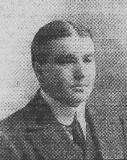
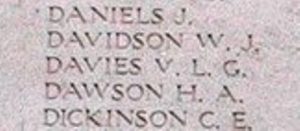
Frederick George Davis, Private, 201932, Royal Berkshire Regiment. Frederick was born in Westbury, Wiltshire in 1880, the son of Sydney Davis and Emily Davis (nee Strugnell). His father was a banker mason who moved the family to South Wales to gain work, and by 1912 the family had moved to Ashfield Cottages, Dardy, Crickhowell. Frederick enlisted into the army at Bristol and upon being drafted to France was posted to the 2/4th Battalion, Royal Berkshire Regiment. The battalion had been in France since 27 May 1916 attached to 184 Brigade, 61st (South Midland) Division. The Divisions first taste of battle was a disaster, as it was thrown into a needless diversionary attack at Fromelles on 19 July 1916, suffering severe casualties for no gain. The Division did not return to action until March 1917 when it followed the German withdrawal to the Hindenburg Line and on 17 March it captured Chaulnes and Bapaume. Later that year the Division moved to Ypres and fought at the Battle of Langemarck, before taking part in the later stages of the Passchendaele offensive, around Schuler Farm and Aisne Farm near Kerselaar. The Division then moved south, where it took part in the Battle of Cambrai, between 20 November and 7 December 1917. The 61st Division saw heavy fighting following the German counterattack of 30 November, when it was ordered to reinforce the units under attack in the area of La Vacquerie. During March 1918 the Division was holding the forward zone of defences in the sector northwest of Saint Quentin, in the area of Ham and lost many men as it fought a chaotic but ultimately successful withdrawal back over the Somme crossings over the next ten days. In the initial clash, the Division faced three enemy Divisions and only began to retire on the afternoon of 22 March, when ordered to do so in consequence of the enemy’s progress at other parts of the line. After suffering heavy casualties, the depleted Division was moved to Flanders to rest, but the Germans launched the second phase of their offensive here just weeks later, seeing the Division in the thick of the action again. The Division was then rebuilt again before joining the great offensive of 21 August 1918 onwards, and took part in the Advance in Flanders, driving the Germans back towards the frontier. The Division advanced from the Forest of Nieppe area and over the coming weeks moved forwards, entering Éstaires on 1 September, then crossed the Lys. The 2/4th Berkshire’s then enjoyed a brief spell out of the line to rest before re-joining the offensive at the beginning of October and over the coming days the Division drove past the southern edge of Cambrai. The 2/4th Berkshire’s billeted at St. Aubert on 23 October then on the following day took over positions along the River Harpies near Montrecourt. Frederick was killed in action here during an assault on the Valenciennes to Avesnes railway line on 25 October 1918. The 38-year-old is buried in Cross Roads Cemetery, Fontaine-Au-Bois, France. Frederick is not commemorated on the Crickhowell war memorial.
Percy William Allen Drew, Private, 1933, South Wales Borderers. Percy was the son of William Drew and Charlotte Louisa Drew (nee Price), of Mill Street, Crickhowell. He worked as a groom prior to enlisting at Brecon into the 1st Brecknockshire Battalion, South Wales Borderers. The battalion had mobilised at Brecon attached to South Wales Brigade, Welsh Division, moving to Pembroke Dock and then Dale. On 29 October 1914 the battalion sailed from Southampton for Bombay, before transferring to Aden, where the battalion took part in a tragic crossing of the desert which saw a number of men die of heatstroke. In August 1915 the battalion embarked for India, arriving at Bombay, before spending the rest of the war on garrison duties in the country. Percy took ill soon after arriving in India and died in Colaba on 21 August 1915. The 20-year-old was buried in Suwri Cemetery, Bombay, but at some time afterwards the military graves were exhumed from there and reburied in a mass grave in Kirkee War Cemetery. As a result, Percy is commemorated on the Kirkee 1914-1918 Memorial, India. Percy is not commemorated on the Crickhowell war memorial, even though his name was among those listed during a memorial service in the town in 1919.
Cecil Ernest Dunn, Private, 200536, Royal Army Service Corps. Cecil, known as Ernest, was the son of Alfred Dunn and Jane Dunn (nee Griffiths), of 14, Claremont Avenue, Rumney, Cardiff. He lived in Crickhowell prior to the war and enlisted at Brecon into the 1st Brecknockshire Battalion, South Wales Borderers. The battalion had mobilised at Brecon attached to South Wales Brigade, Welsh Division, moving to Pembroke Dock and then Dale. On 29 October 1914 the battalion sailed from Southampton for Bombay, before transferring to Aden, where the battalion took part in a tragic crossing of the desert which saw a number of men die of heatstroke. In August 1915 the battalion embarked for India, arriving at Bombay, before spending the rest of the war on garrison duties in the country. At some time after this, Ernest transferred to No. 2 Motor Transport Company, Royal Army Service Corps, but remained in India. Ernest became ill and died in hospital at Rawalpindi on 25 December 1918. The 21-year-old was buried in Rawalpindi War Cemetery, in what is now Pakistan.
Daniel Evans, Sapper, WR/10704, Royal Engineers. Daniel was the son of Thomas and Jane Evans, of Cerrigceinwen, Anglesey. He had moved to South Wales to find work as a young man and enlisted into the Glamorgan Royal Garrison Artillery (Militia) at Merthyr on 15 April 1907. Daniel married Rosetta Davies, of Crickhowell, in 1909 and the couple set up home at Crickhowell, where Daniel had gained a position as a water bailiff. Following the outbreak of war, Daniel enlisted into the Royal Engineers. He then transferred several times, first to the South Wales Borderers, then to the Royal Defence Corps and back to the South Wales Borderers again, before finally being posted to the 303rd Road Construction Company, Royal Engineers, in France. Daniel survived the war but took ill whilst still in France and died of influenza at the 15th Casualty Clearing Station, Annoeullin on 1 December 1918. The 30-year-old was buried in Don Communal Cemetery, Annoeullin, France.
Thomas Edward Fishbourne, Private, 15524, Cheshire Regiment. Thomas was born at Cowbridge on 7 March 1897, the son of Herbert Edward Fishbourne and Catherine Mary Fishbourne (nee Treloar). His father was a gamekeeper and over the coming years the family moved several times. By 1911 the family was residing at Bredwardine, near Hay, but just prior to the war had moved to Dan y Parc, Crickhowell. Thomas enlisted into the Herefordshire Regiment soon after the outbreak of war. He remained in England on home service until early 1916 when he was drafted to France, joining the 1/5th Battalion, Cheshire Regiment, which was the Pioneer Battalion to the 5th Division. March 1916 saw the Division moving to positions between St. Laurent-Blangy and Vimy, near Arras, where it would remain over the coming months. On 1 July 1916 the Battle of the Somme opened to the south, and the Division withdrew from Arras to join the great offensive. The 1/5th Cheshire’s had been based at Souastre over the weeks leading up to the Somme offensive, remaining there until 20 August until moving to Doullens. The battalion then moved with the Division to Corbie by 6 September prior to moving into positions at Contour Wood three days later whilst the infantry battalions of the Division took part in the fighting for High Wood. Whilst the fighting was raging at the front, the 1/5th Cheshire’s toiled hard, digging a series of communications trenches under the most arduous conditions over the coming days. Thomas was one of fifteen men killed whilst digging Ranger Trench, near Bois des Faviere on 21 September 1916. The 19-year-old has no known grave and is commemorated on the Thiepval Memorial, France. Thomas is not commemorated on the Crickhowell war memorial.
Walter Francis Gough, Driver, 67418, Royal Engineers. Walter was born in Taynton, Gloucestershire in 1891, the son of William Gough and Mary Gough (nee Cotterill). The family had moved to Crickhowell when Walter was a young boy. Walter married Laura Powell of Crickhowell in 1901 and the couple had four children over the coming years. Walter worked as a domestic coachman prior to the war and by 1911 the family was residing at Lyne House, Capel, Surrey. Walter returned to Wales to enlist into the Welsh Divisional Royal Engineers soon after the outbreak of war and embarked for France with the Division on 4 December 1915. He was later transferred to the 1st Field Company, Royal Engineers and served on the Western Front with the company for the coming months until taking ill and being evacuated back to Britain. Walter died of tuberculosis at the Brighton Military Hospital on 20 November 1917. The remains of the 36-year-old were conveyed home and he was buried with full military honours in St. Cattwg Churchyard, Llangattock.
John Harrington Herbert, Sergeant, 1897, Oxford and Bucks Light Infantry. John was the son of John George Herbert and Leonora Herbert (nee Harrington), of Crickhowell. His father died in 1900 and three years later his mother married John Storey, of Market Tavern, Abergavenny, where John and his two sisters were raised. John enlisted at Abergavenny into the Monmouthshire Regiment but was then transferred into the 1/4th Battalion, The Oxfordshire and Buckinghamshire Light Infantry. The battalion was at Writtle near Chelmsford, attached to the South Midland Division and on 29 March 1915 landed at Boulogne. In May 1915 the formation became 145 Brigade, 48th (South Midland) Division. He must have been wounded at some time over the coming months and upon returning to Britain, married Eileen Gladys Roberts, a nurse from Birmingham, at Birmingham in the autumn of 1915. John returned to France soon afterwards, re-joining his battalion, which by then was by then in the Hébuterne sector, to the north of the Somme. The battalion was in reserve when the Somme offensive opened on 1 July 1916 and during that afternoon marched to bivouacs at Mailly-Maillet. The battalion moved back into the line on 5 July and carried out a short tour in the line in relative quiet whilst the main fighting raged to the south. The battalion enjoyed a short rest before going back into the line to begin another tour on 12 July, yet again saw little action as fighting raged around Mametz Wood and High Wood, to the south. The battalion then received orders for its part in an assault by the 48th Division on the German positions between Ovillers and Pozieres and during the night of 18 July advanced along the Albert to Bapaume Road, before launching its attack on the following morning, 19 July. The attack failed and the survivors withdrew, before being relieved and marched to bivouacs at Albert. On 23 July the battalion took part in an assault on Pozieres itself, in conjunction with the Australians, and attained its objectives before being relieved again. John was wounded at some time during this fighting, probably at Pozieres, and was evacuated to the 35th Hospital at Rouen, where he died of his wounds on 27 July 1916. The 23-year-old is buried in St. Sever Cemetery, Rouen, France.
Philip Aubrey Hill, Captain, South Wales Borderers. Philip was born in Crickhowell on 13 December 1873, the son of Philip Edward Hill, a surgeon, and Gertrude Marianna Susan Hill (nee Evans). He was educated at The Llandaff Cathedral School, Cardiff; Uppingham School; and at Caius College, Cambridge, graduating MA in 1901. Philip then taught at Sutton Coldfield Grammar School and whilst working there, married Ethel Grace Sadler on 23 April 1902. Philip then became Headmaster of St Andrew’s preparatory School, Bromley, Kent. Having served in the Cambridge University Rifle Volunteers, he was commissioned into the Brecknock Battalion on 15 September 1914 and posted to the 2nd Battalion, South Wales Borderers on 22 January 1917, joining the battalion at Carnoy, where it was attached to 87 Brigade, 29th Division. The Division was withdrawn from the line at the beginning of March 1917 and moved to positions around Bonnay, before being transferred to the Arras sector and took over positions facing Monchy-le-Preux by 12 April. On the following day the battalion relieved the 12th West York’s, just south of Monchy, in readiness for an assault on the village. Four men were killed during the move, and during the following morning the battalion extended its line, relieving the 4th Worcester’s. Nine more men were killed during the day, and on 15 April D Company HQ was blown up by a German shell, burying seven officers and killing Captain Charles Percy Owens. Six of the officers were dug out alive, but two had to be sent back to Arras with shellshock. The 2nd SWB remained in their positions here over the coming days, in support to the 29th Division’s assault on the village. On 23 April the division assaulted Monchy-le-Preux again: the 2nd SWB was the assaulting battalion in 87 Brigade and at 4.45 am went over the top, storming the German front line trench before advancing about 250 metres further and consolidating. The artillery barrage fell short, causing friendly fire casualties, while the battalion, in an advanced position, was subject to a lot of sniping during the day and beat off a counterattack before being relieved during the night by the 1st Lancashire Fusiliers. Philip was one of seven officers from the battalion killed during the terrible fighting that day. The 43-year-old has no known grave and is commemorated on the Arras Memorial, France.
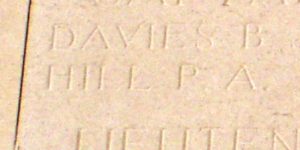
Edward Charles Hodge, Company Sergeant Major, 315603, Royal Welsh Fusiliers. Edward was born in Crickhowell in 1862 and had served with the 24th Regiment of Foot, South Wales Borderers, for over 22 years after having enlisted on 3 May 1879. He married Elizabeth Ann James at Brecon in 1881 and the couple had at least seven children over the coming years. Following Edward’s discharge from the army on 26 June 1901 he moved his family to Welshpool, where he had gained work as a Nightwatchman and a Fireman at Powis Castle. Edward re-enlisted into the 7th Battalion, Royal Welsh Fusiliers at Welshpool on 25 September 1914. The battalion was a Territorial unit, which mobilised for war at Newtown in August 1914, as part of North Wales Brigade, Welsh Division and moved to Conway until the end of the month, before moving to Northampton. Edward was then posted to the 2/7th Battalion, Royal Welsh Fusiliers, which was attached to 203 Brigade, 68th (2nd Welsh) Division at Bedford and became an instructor, being ideally placed to pass on all his experience to new recruits. On 1 January 1917 he was transferred to the 23rd Battalion, Royal Welsh Fusiliers, which was at Hemsby, Norfolk, and he served as Musketry Instructor there until the Armistice. Edward was demobilised on 27 May 1919 and returned home to his wife at Welshpool, but the rigours of almost five years’ service at his age proved too much and his health broke down. Edward died of rheumatic fever and bronchitis at Welshpool on 14 October 1922. The 60-year-old was buried at Welshpool four days later. Edward is not commemorated as a war casualty by the CWGC, and he is not commemorated on the Crickhowell war memorial. His four sons all served during the war, one of which, Thomas Edward Hodge, was killed at Gaza in 1917.
David Lewis Jenkins, Lieutenant, Royal Welsh Fusiliers. David was born on 2 June 1886, the son of Captain David Jenkins, and of Anne Jenkins, of Eukrateia, Llanon. He was educated at Ellesmere College prior to serving an apprenticeship in banking at the Crickhowell Branch of the National and Provincial Bank. He became well known in the town and regularly played for the Crickhowell Rugby and Cricket Clubs. He remained at the branch as a clerk until February 1906, when he moved to Abergavenny branch then moved to the Bute Docks branch in October 1908. In June 1912 David moved to Petre, a sub-branch to Pontypridd, and in August 1913 he moved to the Abergele branch, where he became branch accountant. David enlisted into the King’s Liverpool Regiment straight after the outbreak of war but was soon commissioned as Second Lieutenant into the 5th Battalion, Royal Welsh Fusiliers on 16 September 1914. The battalion was a Territorial unit, which mobilised for war at Newtown in August 1914, as part of North Wales Brigade, Welsh Division and moved to Conway until the end of the month, before moving to Northampton. In December the Division moved to Cambridge and then in May 1915 to Bedford, where the Division was numbered and the formation became 158 Brigade, 53rd (Welsh) Division. On 19 July 1915 the entire Division sailed from Devonport for Imbros and on 9 August 1915 landed at Suvla Bay. The infantry moved off the beaches across the Salt Lake, under shellfire, into the scrub covered Chocolate Hill, but due to a lack of maps and no knowledge of the terrain, many of the units became disorientated, and the situation became chaotic. Soon after the landings, news was received at Crickhowell that David had been killed, but he had in fact been wounded and evacuated to a Hospital Ship waiting offshore. He returned to Gallipoli soon afterwards where he contracted frostbite and was invalided home. David was posted to France on 14 May 1917, joining the 10th Battalion, Royal Welsh Fusiliers, which was at Arras, attached to 76 Brigade, 3rd Division. The Division saw terrible fighting throughout the Battle of Arras, especially during the Third Battle of the Scarpe, where it captured the ruined village of Roeux. The Division then spent a period in the Louverval Sector before being transferred to Ypres at the end of September, to join the great drive on Passchendaele Ridge. The 10th RWF entrained at Brandhoek on 26 September and detrained at Ypres Asylum, before marching forwards across the Hannebeke to its new positions facing Zonnebeke. At 03.40 the following morning, 26 September 1917, the Divisional artillery opened fire upon the German positions in the ruined village, before the 10th RWF assaulted the village of Zonnebeke. Heavy casualties were suffered in the vicinity of the railway station, before the battalion captured the ruins of the Church, in the centre of the village. David was killed in action during the terrible fighting for Zonnebeke that day. The 31-year-old has no known grave and is commemorated on the Tyne Cot Memorial, Belgium. David is not commemorated on the Crickhowell war memorial.
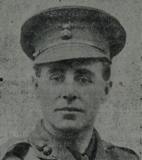
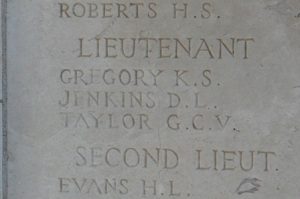
Llewellyn Maynard Jenkins, Second Lieutenant, Welsh Regiment. Llewellyn was born at Myniddislwyn in 1887, the son of Isaac Jenkins and Anne Jenkins. His father was a Solicitor and the family later resided at Oaklands, Crickhowell. Llewellyn was commissioned as Second Lieutenant into the Welsh Regiment on 1 January 1916 and was posted to France, joining the 10th Battalion, Welsh Regiment, which was attached to 114 Brigade, 38th (Welsh) Division. Llewellyn joined D Company of the battalion, under the command of Captain Littlejohns. The Division was holding a sector of the line near Cuinchy before marching south to the Somme sector in June 1916 to take part in the assault on Mametz Wood. The first attack on the wood was launched on a two-battalion front on 7 July, but failed, and the Divisional Commander, Sir Ivor Philipps, was replaced before the Division attacked again on a two Brigade front on 10 July 1916. After two days of ferocious hand-to-hand fighting, the wood was cleared up to its northern edge, before the battered Division was relieved. It then took over a section of the front at Hébuterne before moving to the Ypres Salient and taking over the Canal Bank sector at Boesinghe. The infantry battalions of the Division then began carrying out the normal pattern of rotation in the trenches, four days in the front, four in support and four in reserve, whilst also working on trench improvement, digging new trenches, and also carrying out regular patrols and trench raids. The 10th Welsh, during this period, also supplied a large number of officers and men to assist the 177th Tunnelling Company, Royal Engineers in their work constructing deep dugouts beneath the Canal Bank line. Llewellyn was wounded whilst at work on the Canal Bank at the beginning of December and died of his wounds on 2 December 1916. The 29-year-old is buried in Ferme Olivier Cemetery, Ieper, Belgium. Llewellyn in not commemorated on the Crickhowell war memorial.
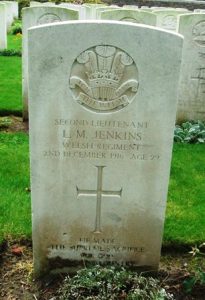
David John Johns, Private, 2029, South Wales Borderers. David was the son of John Johns and Maria Johns, of Bridge Street, Crickhowell. He worked as a mason prior to enlisting into the Brecknockshire Battalion, South Wales Borderers at Brecon on 6 August 1914 having had already served for six years with the battalion. The battalion was posted to Pembroke Dock soon after mobilisation, but soon after arriving there, David began to suffer from problems with his health. He was discharged as medically unfit from the army at Fort Hubberston on 17 December 1914 and returned home to Crickhowell. Nothing further is currently known of David, but he possibly re-enlisted into another unit. To have been commemorated on the Crickhowell war memorial. No trace of him nor his death can be found.
Walter Jones, Private, 10/396, New Zealand Expeditionary Force. Walter was born on 23 April 1893, the son of John Jones and Caroline Jones (nee Peters), of Gelli Fanw, Llanbedr, Crickhowell. He was educated at Crickhowell National School and at Brecon County School before emigrating to New Zealand in September 1911 and lived at Hunterville, New Zealand, where he had found work as a shepherd. Walter enlisted into the New Zealand Expeditionary Force on 15 August 1914 and was posted to the Wellington Regiment. He embarked with the battalion at Wellington on 16 October 1914 and sailed as part of the newly formed Anzac Corps to Egypt. The Anzac’s were originally destined for the Western Front and began training in earnest near Cairo but following the decision to attempt to force Turkey out of the war, this new force was instead retained in the Middle East, before landing on the shores of Gallipoli on 25 April 1915. Walter survived the terrible fighting during the initial landings but was badly wounded during further fighting on 8 May and died of his wounds two days later, 10 May 1915. The 22-year-old is buried in Twelve Tree Copse Cemetery, Gallipoli. (Differing reports state that he was killed in action on 8 May, but his service papers show otherwise).
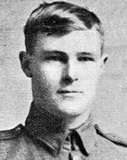
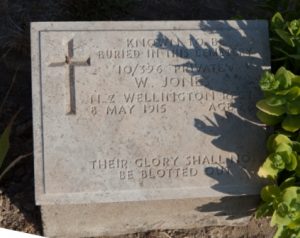
David John Joseph, Private, R4/307951, Royal Army Service Corps. David was the son of Price Joseph and Margaret Joseph (nee Williams), of Myrtle House, Llangammarch Wells. He worked as a groom prior to enlisting into the Breconshire Constabulary as a young man and was posted at Crickhowell Police Station. David married Gertrude Elsie Jones at Abergavenny on 24 June 1913 and the couple set up home at the Police Station. David enlisted into the Army Service Corps (Remounts) at Bristol on 29 September 1915 and was posted to the Depot at Shirehampton. On 29 August 1916 he was posted to the 60th Remount Squadron at Bulford, but about six months later began suffering with his health. David was hospitalised at Bulford where he was found to be suffering from phthisis, contracted during his service, and he was discharged from the army as medically unfit on 18 June 1917, with a full pension. He returned home to his wife at Crickhowell and died there of tuberculosis on 18 February 1919. The remains of the 31-year-old were buried with his father in Llanlleonfel Churchyard, Garth. David has today, Saturday 17 December 2022, been accepted for commemoration by the CWGC, who will commemorate him in the United Kingdom Book of Remembrance at Maidenhead, until the location of his grave is verified.
Alfred John Kelsall, Gunner, 604427, Royal Field Artillery. Alfred was born at Crickhowell in 1896, the son of John Kelsall and Vashtie Rosean Kelsall (nee Cooke). By 1901 the family had moved to Shrewsbury. Alfred enlisted at Shrewsbury into the Shropshire Battery, Royal Horse Artillery, a Territorial Army unit. He initially served with the 2/1st Shropshire Battery, RHA, which joined the 2/1st Welsh Border Mounted Brigade and moved to Northumberland in January 1915, becoming attached to the 63rd (2nd Northumberland) Division. In March 1916, the brigade joined the 1st Mounted Division to replace the 1st Welsh Border Mounted Brigade which was dismounted for service in Egypt. The battery then merged with the 2/1st Berkshire RHA at Heytesbury, Wiltshire on 13 April 1917 before embarking for France and upon disembarking at Boulogne on 24 May 1917 became an Army Field Brigade and was subsequently redesignated as the 158th Battery, Royal Field Artillery. Alfred was killed in action almost a year later, whilst the battery was targeting advancing German troops on 28 March 1918, during the German offensive. The 21-year-old is buried in St. Nicolas British Cemetery, France. His brother, Edward, had been killed just six days earlier. Neither of the men are commemorated on the Crickhowell war memorial.
Edward Henry Kelsall, Private, 50402, South Lancashire Regiment. Edward was born at Crickhowell in 1897, the son of John Kelsall and Vashtie Rosean Kelsall (nee Cooke). By 1901 the family had moved to Shrewsbury. Edward enlisted at Shrewsbury into the army and was drafted to France in the winter of 1917, joining the 2nd Battalion, South Lancashire Regiment, which was attached to 75 Brigade, 25th Division. The Division had been at Ypres and had taken part in the Battle of Pilckem Ridge, before moving south at the beginning of December, taking up positions around Bullecourt in reserve. The Division then wintered in the Bullecourt Sector. On 20 March the 2nd South Lancs were working on defences around Beugnatre. At dawn on the following morning, 21 March 1918, the men were awoken by the terrible sound of artillery fire, which heralded the opening bombardment by the Germans upon the British lines, which was followed up by a massed infantry assault. The resulting battle was known as the German Spring Offensive, or Operation Michael, and broke the British lines in front of the Somme sector. Edward’s battalion then received orders to man the Vaulx-Morchies Line, while one Company formed a flank on the high ground north of Vraucourt. At dawn the following morning, 22 March 1918, the Germans hit the battalion and terrible fighting ensued. Edward was killed in action at some time during the morning. The 20-year-old has no known grave and is commemorated on the Pozieres Memorial, France. His brother, Alfred, was killed just six days later. Neither of the men are commemorated on the Crickhowell war memorial.
Alfred Jeffreys Leonard, Private, 10/1561, New Zealand Expeditionary Force. Alfred was the son of John Leonard and Caroline Leonard (nee Blacker), of Glencoe House, Crickhowell. He had worked for the National and Provincial Bank at Crickhowell and had played both rugby and football for the town prior to emigrating to New Zealand in 1910. Albert then worked as a miner and lodged at the Kenilworth Hotel, Gisborne, New Zealand. He enlisted into the New Zealand Expeditionary Force at Trentham on 4 December 1914 and was posted to the 3rd Reinforcements for the Wellington Regiment. Alfred embarked from Wellington with the 3rd Reinforcements on 14 February 1915 and disembarked in Suez, to join the Wellington Regiment, which was already camped in Egypt, attached to the Anzac Corps. The Anzac’s were originally destined for the Western Front and began training in earnest near Cairo but following the decision to attempt to force Turkey out of the war, this new force was instead retained in the Middle East, before landing on the shores of Gallipoli on 25 April 1915. Due to poor strategy, the initial landings failed to break the Turkish defences and the campaign soon bogged down into a stalemate similar to that on the Western Front. The Allies built up their forces on the Peninsula over the coming months, then on 6 August 1915 launched a series of offensives, to divert Turkish attention away from fresh landings at Suvla Bay. Alfred was badly wounded during the terrible fighting of 8 August which saw the New Zealanders capture the summit of Chunuk Bair and was evacuated off the Peninsula aboard the Hospital Ship Georgian. He died of his wounds in Mudros Bay on 14 August 1915. The body of the 28-year-old was carried from the ship, and he was buried in East Mudros Military Cemetery, Greece.
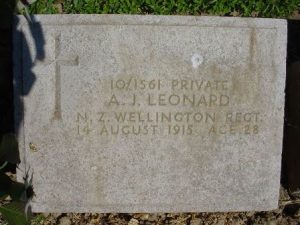
George Vincent Leslie, Private, 7433, Gloucestershire Regiment. George was born in London in 1884, the son of George Herbert Leslie and Annie Leslie (nee Phillips). He came to South Wales as a young man to find work as a signalman for the Post Office and lived at 20, Trevor Street, Aberdare. George married Minnie Elizabeth Bird at Crickhowell on 28 April 1909 and the couple had two children over the coming years. George must have had some prior military service as he enlisted into the 1st Battalion, Gloucestershire Regiment straight after the outbreak of war and embarked for France with the battalion on 13 August 1914. Minnie then moved with their two children to The Cottage, Yew Road, Crickhowell. The battalion was attached to 3 Brigade, 1st Division and moved to the Belgian frontier near Mons with the BEF. The Division suffered heavy casualties during the opening months of the war, taking part in the Battle of Mons and the subsequent retreat to the Marne, and then helped stop the Germans at the Battles of the Marne and Aisne, before the BEF moved to Ypres in the middle of October. The Division then played a vital role in stopping the Germans capturing the important city, during the First Battle of Ypres, seeing its first major action at Langemarck on 21 October, during an action named by the Germans as ‘Der Kindermord bei Ypern’, or the ‘Massacre of the Innocents’, when scores of young German student soldiers were cut down by the highly skilled riflemen of the BEF. The 1st Division was relieved on 24 October and took over positions east of Ypres, along the Menin Road at Gheluvelt. On 29 October 1914 the Division was hit hard by overwhelming numbers of German troops and terrible fighting raged throughout the day, in a desperate defensive action. George was killed in action during this day of fighting. The 30-year-old was originally buried on the battlefield, but his grave was later found and after the war he was re-interred in Tyne Cot Cemetery, Belgium. George is not commemorated on the Crickhowell war memorial.
Gilbert David Lewis, Private, 119376, Royal Army Medical Corps. Gilbert was the son of Richard and Anne Lewis, of 21, Llanbedr Road, Crickhowell. He worked as a hotel handyman and groom prior to enlisting into the Royal Army Medical Corps at Brecon on 24 June 1916 and was placed on the Army Reserve. Gilbert was mobilised on 7 June 1917 and attested at the RAMC Depot at Blackpool. He was subsequently found to have cataracts in each eye and was hospitalised for a short while before being discharged from the army as medically unfit on 23 July 1917 and returned home. Gilbert then resumed his work as a hotel handyman. Sadly, he contracted influenza and died at home on 29 October 1918, the day after his mother. The 40-year-old was buried with her in Bethabara Baptist Churchyard. Gilbert is not commemorated as a casualty of war by the CWGC, as his death was not related to his service.
Montagu Wilfred Markham, Second Lieutenant, Scots Guards. Montagu, known as Wilfred, was born at Folkestone on 20 November 1884, the son of Lieutenant-General Sir Edwin Markham and Emily Evelyn Lucy Markham (nee Stopford), and was the grandson of Vice Admiral Sir Montagu Stopford, KCB. He came to Crickhowell as a young man to work as an estate manager for Lord Glanusk before becoming agent to the Duke of Beaufort at Badminton. Wilfred married Dorothy Ram in Kensington on 17 September 1914 and the couple later had a daughter, Rosemary, born on 14 July 1916. Wilfred was commissioned as Second Lieutenant into the Scots Guards and was drafted to France, joining the 2nd Battalion, Scots Guards, which was attached to the 3rd Guards Brigade, Guards Division. He probably saw his first action during the Battle of the Somme, where the Guards Division took part in the Battle of Flers-Courcelette, where tanks were used for the first time. The Guards then fought at the Battle of Morval, capturing Lesboeufs Village. The Guards Division remained on the Somme for the winter, and in March 1917 took part in the advance caused by the German retreat to the Hindenburg Line. Later that year the Guards moved north to Ypres, taking over positions north of the 38th (Welsh) Division, and took part in the opening assault of the Battle of Passchendaele, during the Battle of the Pilckem Ridge on 31 July. After a brief rest, the 2nd Scots Guards took over the front line at Bleuet Farm on 27 August, holding positions which consisted of a number of posts across the Steenbeek. Wilfred was posted as wounded and missing during this spell in the line and was later adjudged to have been killed in action there on 29 August 1917. The 32-year-old has no known grave and is commemorated on the Tyne Cot Memorial, Belgium. Wilfred is not commemorated on the Crickhowell war memorial.
Edwin Morgan, Rifleman, 25915, New Zealand Expeditionary Force. Edwin was the son of Edwin and Jane Morgan, of Castle Cottage, High Street, Crickhowell. He emigrated to New Zealand together with an elder brother, Joseph as a young man and found work as a bricklayer’s labourer in Gisborne. Edwin enlisted into the New Zealand Expeditionary Force at Gisborne on 10 May 1916 and was posted to Trentham, joining the 28th Reinforcements. Edwin sailed for Britain with the unit from Wellington on 25 September 1916 and disembarked at Devonport on 21 November 1916, joining the 5th Reserve Battalion, New Zealand Expeditionary Force at Sling. He embarked for France on 7 January 1917 joining the 4th Battalion, 3rd New Zealand Rifle Brigade, which formed part of the New Zealand Division. Edwin’s first major action was when the New Zealanders took part in the Battle of Messines Ridge on 7 June 1917, which resulted in probably the greatest Allies victory of the war, so far. Edwin was wounded at Messines but re-joined his battalion in time to take part in the Battle of Passchendaele. The New Zealanders were then thrown into action following the launching of Operation Michael, and saw further heavy fighting before being transferred south, to the Somme valley. Edwin was killed in action on the Somme on 10 May 1918. The 21-year-old is commemorated on the Grevillers (New Zealand) Memorial, France. His brother, William, had died of wounds on the Somme in 1916.
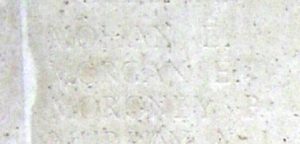
Fothergill Lewis Morgan, Second Lieutenant, London Regiment. Fothergill was born at Abergavenny on 14 November 1889, the son of Lewis James Morgan and Ellen Morgan (nee Jones). He came to Crickhowell to run his own greengrocers store as a young man and was a member of the Penmyarth Golf Club, the Crickhowell Cricket Club and the Unionist Working Men’s Club. Fothergill married Ethel Beatrice May Norman at Cambridge in 1915. He enlisted into the 5th Battalion, London Regiment soon after the outbreak of war and was later commissioned as a Second Lieutenant, before being posted to the 1/7th Battalion, London Regiment. The battalion was in France attached to 140 Brigade, 47th (2nd London) Division. The Division was north of Arras when the Germans attacked Vimy Ridge in the Spring of 1916, and then moved south to the Somme soon afterwards, to join the great offensive there. The Division then saw heavy fighting at the Battle of Flers-Courcelette, and then at the Battle of Le Transloy, where the Division captured Eaucourt l’Abbe, and took part in Attacks on the Butte de Warlencourt. Early in 1917 the Division moved north to Belgium, and took part in the Battle of Messines Ridge, and then in November 1917 moved to the Arras Sector to take part in the Battle of Cambrai. Fothergill was badly wounded following the German counterattack at Cambrai and was evacuated to the 48th Casualty Clearing Station, where he died of his wounds on 3 December 1917. The 28-year-old was buried in Rocquigny-Equancourt Road British Cemetery, Manancourt, France.
William Morgan, Private, 9547, South Wales Borderers. William was the son of Edwin and Jane Morgan, of Castle Cottage, High Street, Crickhowell. He enlisted at Brecon into the South Wales Borderers as a young man and by 1911 was serving in South Africa with the 2nd Battalion, South Wales Borderers. The battalion was in Tientsin, China at the outbreak of war and took part in a famous operation with the Japanese against the German held port of Tsingtao on 23 September. On 4 December the battalion embarked at Hong Kong and landed at Plymouth on 12 January 1915, entraining for Rugby to join 87 Brigade, 29th Division. On 17 March 1915 the battalion sailed from Avonmouth with the Division, arriving at Alexandria on 29 March, before moving to Mudros. On 25 April 1915 the Division landed at Cape Helles, Gallipoli, as part of the original landing force which had been despatched to try and seize the Dardanelles Straits and force Turkey out of the war. The invasion forces failed to break the Turkish defences and the campaign became bogged down, so after an arduous eight months on the Peninsula the 29th Division was evacuated to Egypt on 11 January 1916, before being transferred to the Western Front, landing at Marseilles on 15 March and entraining for the Somme sector, taking up positions near Beaumont Hamel, facing Y-Ravine. The Division had an arduous time here too over the coming months, before taking part in a suicidal assault on 1 July 1916, on the opening day of the Somme offensive. The 2nd SWB alone suffered some 384 casualties on that day alone. Although severely depleted, the Division remained in the line here over the coming weeks, in trying conditions. William had unsurprisingly had enough, as he was posted as having died of self-inflicted wounds on 23 July 1916. The 27-year-old was buried in Acheux British Cemetery, France. A younger brother, Edwin, was killed in France in 1918.
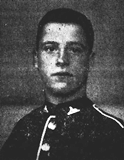
William John Morgan, Private, 57464, Manchester Regiment. William was born in Crickhowell in 1898, the son of Owen John Morgan and Maggie Jane Morgan (nee Lewis). His father worked as a coalminer, so the family moved to Aberdare and then to Merthyr Tydfil over the coming years. William enlisted at Merthyr into the Welsh Regiment and was drafted to France on 13 October 1915, joining the 1st Battalion, Welsh Regiment, which was at Loos attached to 84 Brigade, 28th Division. Soon afterwards the Division was transferred to Salonika, as part of a large Allied force sent to hold the Greek frontier, following the invasion of Serbia by a combined Austro-Bulgarian force. William was probably wounded at some time after this, as he later transferred to the 1/8th Battalion, Manchester Regiment. The battalion had served in Gallipoli and in Egypt with 127 Brigade, 42nd (East Lancs) Division before moving to France in March 1917, taking over the line near Épehy then Havrincourt. In September the Division moved north to Ypres and fought throughout the early stages of the Passchendaele offensive, until moving to the Coast in September to refit. November 1917 saw the Division moving to positions at Givenchy, where it remained until moving back south in early 1918. The Division then faced the German Spring Offensive of 21 March and saw heavy fighting as the line was driven back by the Germans. The offensive stalled for several months, until an Australian victory at Villers Bretonneux on 8 August saw the tide of war turn. The British attacked the German lines on the Somme on 21 August, with the 42nd Division in the line at Bertrancourt, and began the great offensive that was eventually to end the war. Over the coming days the 42nd Division advanced through Puisieux, Miraumont and Pys, towards the direction of Bapaume. William was killed during the advance on Riencourt on 30 August 1918. The 18-year-old is buried in Riencourt-Les-Bapaume, France. William is not commemorated on the Crickhowell war memorial.
Charles Bernard Parsons, Private, 129501, Machine Gun Corps. Charles was the son of James Parsons and Annie Parsons (nee Price), of the Cross Keys Inn, Crickhowell. He worked as a bus conductor for the Great Western Railway from Abergavenny to Brecon prior to enlisting into the Monmouthshire Regiment at Abergavenny. Charles was drafted to France early in 1916 and saw action during the Somme offensive that summer. He was underage when he enlisted and was sent home in October 1916, going home on leave before being transferred to the Royal Welsh Fusiliers. As soon as he turned 18, Charles was drafted back out to France, where he was posted to the 4th Battalion, Machine Gun Corps, which was attached to the 4th Division. Charles took ill during the Spring of 1918 and returned home on leave, where he sadly took ill. He was taken to the German Prisoner of War Hospital at Crickhowell, where he sadly died of pneumonia on 17 May 1918. The 18-year-old was buried with full military honours in Crickhowell Cemetery. His uncle, Horace Stanley Parsons, died in India in 1918.
Horace Stanley Parsons, Private, 201306, South Wales Borderers. Horace was the son of William and Mary Ann Parsons, of Silver Lane, Crickhowell. He resided at Brynmawr prior to the war, where he worked as a grocer’s assistant, and played rugby for the Brynmawr Rugby Club. Horace enlisted into the 2/1st Brecknockshire Battalion, South Wales Borderers at Brecon at some time after the outbreak of war and was drafted out to India in 1916, joining the 1/1st Brecknockshire Battalion, which was on garrison duty at Mhow. Horace sadly became ill whilst in India and died of disease at Mhow on 17 October 1918, less than a month before the Armistice. The 35-year-old was buried in a mass grave in Mhow New Cemetery, Madhya Pradesh, so is commemorated on the Kirkee 1914-1918 Memorial, India. His nephew, Charles Parsons, died at home in 1918.
Samuel Sidney Powell, Driver, 2188, Australian Infantry. Samuel, known as Sidney, was the son of Samuel Powell and Elizabeth Powell, of Crickhowell. His parents died when he was young, and Sidney emigrated to Australia in 1912 to find work as a miner. He enlisted at Liverpool, New South Wales into the 6th Reinforcements for the 2nd Battalion, Australian Infantry on 26 April 1915, the day after the original battalion landed at Anzac Cove, Gallipoli with the 1st Australian Division. Sidney embarked with the 6th Reinforcements at Sydney on 15 June 1915 and after a brief stay in Egypt, landed at Gallipoli on 6 August, joining the battalion just prior to the Australian assault on Lone Pine. Sidney was wounded during the terrible fighting for Lone Pine and after treatment in hospital in Mudros was evacuated to St. Patrick’s Hospital at Malta aboard the Hospital Ship Asconia. He was then transferred to Ghair Tuffeiha Camp before being sent to England and was treated at Fulham Military Hospital. By the time he had recovered, the Australians had been evacuated from Gallipoli to Egypt and Sidney re-joined his battalion near Cairo on 5 March 1916. The 1st Australian Division was sent to France soon afterwards and took over positions south of Armentières to acclimatise to the Western Front conditions. The Australians were then sent south to the Somme and took part in terrible fighting for the village of Poziéres and in the ensuing assault on Mouquet Farm. In September, I Anzac Corps was withdrawn from the Somme and sent to Ypres for a brief rest but returned to the Somme to take part in the latter stages of the Somme offensive and saw heavy fighting around Gueudecourt during the Battle of Le Transloy. The Australians followed the German withdrawal to the Hindenburg Line in March 1917 and on the following month captured the villages of Hermies, Boursies and Demicourt before taking part in the terrible First Battle of Bullecourt. The Australians were relieved in May and moved to Ypres for a rest before entering the fray again for the assault on Passchendaele Ridge, seeing terrible fighting around Polygon Wood and at the Battle of Broodeseinde. The Australians wintered in Flanders, engaging in vigorous patrolling and raiding over the coming months. The 1st Division was still at Messines when Sidney was badly wounded to the head by shrapnel on 13 March 1918. He died of his wounds at the 1st Australian Casualty Clearing Station later that same day. The 29-year-old was buried in Kemmel Chateau Military Cemetery, Belgium. His nephew, Reginald James Price, also served with the Australians, and died of influenza at Charleroi in 1919.
John Harold Price, Gunner, 165025, Royal Garrison Artillery. John was the son of Rees and Mary Price, of High Street, Crickhowell. He enlisted at Cardiff into the Royal Garrison Artillery and came home on leave in October 1917 prior to embarking for France, joining the 182nd Siege Battery, Royal Garrison Artillery. John joined the battery at Ypres, where it was supporting the infantry assault on Passchendaele Ridge. Sadly, he had been at the Front for less than three weeks, when he was killed in action as a result of German counter-battery fire on 29 November 1917. The 22-year-old has no known grave and is commemorated on the Tyne Cot Memorial, Belgium. His twin brother, Frank, survived the war.
Reginald James Price, Driver, 8063, Australian Infantry. Reginald was the son of James Albert Price and Mary Ann Price (nee Powell), of Crickhowell. He emigrated to Australia with his parents prior to the war and the family set up home at Ivanhoe Street, West Guildford, Western Australia. Reginald found work as a labourer prior to enlisting into the Australian Field Artillery at Perth on 14 August 1915. He embarked for Egypt soon afterwards and disembarked at Suez on 21 December 1915. Reginald then had a brief spell in hospital before re-joining the Australian Camp at Alexandria and joined the 16th Battery, Australian Field Artillery. By now the main Australian force had been evacuated from Gallipoli, and in March 1916 the Australians embarked for France, taking over positions south of Armentières to acclimatise to the Western Front conditions. The Australians were then sent south to the Somme and took part in terrible fighting for the village of Poziéres and in the ensuing assault on Mouquet Farm. In September, I Anzac Corps was withdrawn from the Somme and sent to Ypres for a brief rest but returned to the Somme to take part in the latter stages of the Somme offensive and saw heavy fighting around Gueudecourt during the Battle of Le Transloy. The Australians followed the German withdrawal to the Hindenburg Line in March 1917 and on the following month captured the villages of Hermies, Boursies and Demicourt before taking part in the terrible First Battle of Bullecourt. The Australians were relieved in May and moved to Ypres for a rest before entering the fray again for the assault on Passchendaele Ridge, seeing terrible fighting around Polygon Wood and at the Battle of Broodeseinde. The Australians wintered in Flanders, engaging in vigorous patrolling and raiding over the coming months. The Australians saw further action on the Lys following the launching of the German Spring offensives of March and April 1918, then moved to the Somme valley, where they took part in a famous victory at Villers-Bretonneux on 8 August. The Australians then took part in the great advance to the Hindenburg Line, but before it could be breached were relieved from the line as a result of excessive losses. Reginald remained overseas as part of the Army of Occupation after the Armistice. He took ill at the beginning of February 1919 and was taken to the 20th Casualty Clearing Station at Charleroi where he died of influenza on 12 February 1919. The 22-year-old is buried in Charleroi Communal Cemetery, Belgium.
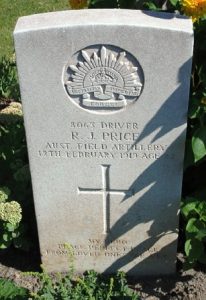
Philip Price Prosser, Driver, SE/7514, Royal Army Veterinary Corps. Philip was born at Llanbedr in 1867, the son of Thomas Prosser and Elizabeth Prosser (nee Powell). The family then moved to Maesllyn Cottage, Crickhowell. Philip left home as a young man to enlist into the South Wales Borderers, but by 1901 had moved to Brighton to work as a coachman and where he married Ellen Knight. By 1911 the couple had moved to Brighton, where Philip was working as a footman. He enlisted at Brighton into the Royal Army Veterinary Corps and embarked for France on 7 September 1915 attached to the 34th Veterinary Section, which was attached to the 22nd Division. The Division’s stay in France was to be very short, as on 27 October 1915 the Division, having been moved by train to Marseilles, began to embark for Salonika. It completed concentration there in November, joining the Allied forces being built up to protect the Greek border, following the invasion of neighbouring Serbia by a combined Austro-Hungarian offensive. Philip took ill during the following summer and was evacuated aboard the Hospital Ship Goorkha but sadly died at sea on 1 September 1916, aged 48. Philip has no known grave as he was buried at sea, so is commemorated on the Chatby Memorial, Egypt.
Roger Frederick Pugh, Private, 1987, Monmouthshire Regiment. Roger was the son of William and Eliza Pugh of 10, Castle Street, Crickhowell. He enlisted into the Royal Artillery at Bedwellty in 1891 and was posted to The Citadel, Plymouth. Roger served with the Royal Garrison Artillery during the South African War of 1899-1902 and then served in India, Africa and in America prior to leaving the forces and returning home. When the Great War broke out, Roger enlisted into the 3rd Battalion, Monmouthshire Regiment. The battalion mobilised at Abergavenny attached to the Welsh Border Brigade, Welsh Division, before moving to Pembroke Dock. On 10 August 1914 the Division moved to Oswestry before moving to Northampton, then spent Christmas at Bury St. Edmunds before moving to Cambridge. In February 1915 the 3rd Monmouth’s left the Welsh Division and landed in France on 14 February, before moving to the Ypres Salient. On 3 March 1915 the battalion joined 83 Brigade, 28th Division. The Division saw its first major action during the Second Battle of Ypres, following the launching of a German gas attack at Gravenstafel on 22 April. The Division suffered such terrible casualties that the three Monmouth battalions were merged on 27 May. The battalions resumed their identities in August, then the 3rd Monmouth’s became the Pioneer Battalion to the 49th (West Riding) Division. Over the coming weeks the 3rd Monmouth’s began work on improving the defences along the Canal Bank sector at Boesinghe, held by the 49th Division. On 29 December 1915 the battalion was in No 4 camp when four 17” German artillery shells crashed into the camp, killing Roger and 68 other men. Roger, who was 41 years old, was buried together with his comrades in what is essentially a mass grave in Ferme Olivier Cemetery, Ieper, Belgium.
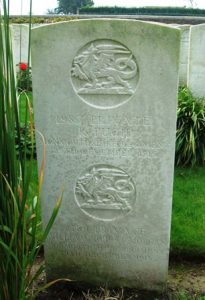
Ronald Hugh Wilson Robertson, Private, 614751, Canadian Infantry. Ronald was born at Southend on 23 August 1879, the son of Charles Robertson and Helen Emme Maryon Robertson (nee Wilson). He came to Crickhowell as a young man to work on Lord Glanusk’s Breconshire estate, before becoming agent to the Duke of Beaufort at Badminton. Ronald had served for several years with the Brecknockshire Battalion, South Wales Borderers and was the donor of the Robertson Cup, which was shot for every year. He emigrated to Canada prior to the war and worked as an accountant at Vancouver. Ronald enlisted into the Canadian Expeditionary Force at Vernon, British Columbia on 30 July 1915 and in October 1915 embarked for England before being drafted to France in March 1916, joining the 29th Battalion, Canadian Infantry, which was at Ypres attached to the 6th Brigade, 2nd Canadian Division. Ronald took part in the famous Canadian action at Mount Sorrel soon afterwards, then fought with the Canadians throughout their desperate attacks on Mouquet Farm and Regina Trench during the summer of 1916. He was shot in the face and wounded on 6 February 1917 but remained on duty, before being evacuated to hospital for treatment. Upon his recovery he went back home on leave, re-joining the battalion at Maroc on 7 August 1917. On 18 August the 29th Battalion moved into the front-line to begin a tour, with orders to carry out an assault to clear the enemy from Lens. The attack began at dawn on 21 August 1917 and heavy fighting raged throughout the day, with no real gain. Ronald was killed in action during the fighting during that day, in an assault which saw the battalion suffer almost 250 casualties. The 37-year-old has no known grave and is commemorated on the Vimy Memorial, France.
Charles Gordon Rumsey, Lieutenant, South Wales Borderers. Charles was born in 1892, the son of Walter Parry Rumsey and Annie Matilda Rumsey (nee Vaughan). He was raised at Greenhill Villa, Crickhowell, before the family moved to Danygarth House, Aberbeeg. Charles was educated at Aberystwyth University, graduating with his BSc in July 1914. He had been a Sergeant in the University of Wales OTC and was commissioned as Second Lieutenant into the 3rd Battalion, South Wales Borderers on 15 August 1914. Upon being posted to France he was transferred to the 1st Battalion, Welsh Regiment. The battalion landed in France on 18 January 1915 attached to 84 Brigade, 28th Division, moving to positions near Ypres. It saw its first major action during the Second Battle of Ypres that year, during heavy fighting at Hill 60. Charles was promoted Lieutenant on 1 May 1915. On 25 May 1915 the 1st Welsh made a gallant attack on the German positions at Bellewaarde Ridge, and Charles was last seen heading a group of men who charged up the ridge into Railway Wood. Charles is one of six officers and 123 men of the 1st Welsh who were killed that day. The 23-year-old has no known grave and is commemorated on the Ypres (Menin Gate) Memorial, Belgium. He is also commemorated on war memorials at Aberystwyth University and at Llanhilleth Institute. His cousin, Douglas Rumsey, was killed at Ypres in 1917.
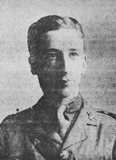
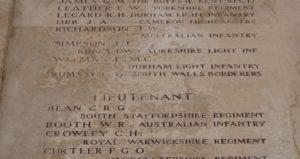
Douglas Victor Rumsey, Gunner, 80039, Royal Garrison Artillery. Douglas was the son of William Rumsey and Margaret Rumsey, of Bridge Street, Crickhowell. He worked as a gardener prior to enlisting into the Royal Garrison Artillery at Brecon on 14 January 1916, initially joining the Army Reserve, but was mobilised on 15 March 1916 and was sent to No. 2 Depot at Fort Brockhurst, Gosport for training. Douglas initially served on the Gosport Defences before being drafted to France on 8 June 1916, initially joining the 156th Siege Battery, Royal Garrison Artillery. He then spent time at the Depot in France and then with 42 Company, RGA, before being posted to the 355th Siege Battery, RGA on 29 January 1917. Douglas joined the battery prior to its move to Ypres, where it played a vital part in the softening up process necessary for the Passchendaele offensive. Douglas was wounded during the latter stages of the offensive and was evacuated to the 4th Casualty Clearing Station at Proven, where he died of his wounds on 4 November 1917. The 19-year-old is buried in Mendinghem Military Cemetery, Belgium. His cousin, Charles Rumsey, had been killed at Ypres in 1915.
John Thomas Rumsey, Private, 201225, South Wales Borderers. John was the son of John and Anne Rumsey, of 1, Twyne, Crickhowell. He worked as a farm servant at Abergavenny prior to enlisting at Brecon into the Brecknockshire Battalion, South Wales Borderers. On 29 October 1914 the battalion sailed from Southampton for Bombay, before transferring to Aden, where the battalion took part in a tragic crossing of the desert which saw a number of men die of heatstroke. In August 1915 the battalion embarked for India, arriving at Bombay, before spending the rest of the war on garrison duties in the country. John became ill towards the end of the war and died of influenza at Mhow on 24 October 1918. The 22-year-old was buried in Mhow New Cemetery, Madhya Pradesh, India, in what amounts to a mass grave, so is commemorated on the Kirkee 1914-1918 Memorial, India.
William Livingstone Thomas, Private, 63419, South Wales Borderers. William was born in Crickhowell in 1892, the son of Andrew Thomas and Mary Jane Thomas (nee Payne). By 1901 the family had moved to Sirhowey, where Andrew worked as a colliery smith and William became a coal hewer there after leaving school. William enlisted into the South Wales Borderers early in 1918, but never served overseas. His health was probably already poor when he enlisted and on 8 January 1919 he was discharged from the army as medically unfit, due to debility aggravated by his time in the army and returned home to Sirhowey. William’s health continued to fail, and he died of tuberculosis on 1 September 1921. Nothing further is known of him, as he is not commemorated by the CWGC.
George Francis Wilband, Private, 55285, Royal Fusiliers. George was born at Basingstoke in 1882, the son of John Wilband and Jane Phyllis Wilband (nee Stidworthy). He became a gamekeeper as a young man and moved around the country several times. By 1901 he was working at Borreaton Park, Baschurch, Shropshire, and in 1903 married Anne Haycock, a domestic servant at Borreaton Hall. The couple had moved to Lower Cockleford, near Cheltenham by 1911 and then moved to Crickhowell after George had gained the position of Head Gamekeeper for Colonel Robert Preston Sandeman, at Dan y Parc, Crickhowell. George enlisted at Brecon into the Army Service Corps soon after the outbreak of war. He was subsequently transferred to the 7th Battalion, Royal Fusiliers, which was at Falmouth. The battalion landed at Le Havre on 24 July 1916, to join 190 Brigade, 63rd (Royal Naval) Division. The Division, as its name suggests, was originally formed of Royal Naval units which had been created from the surplus of sailors and adapted for service as infantry. It had taken part in the fall of Antwerp, then fought throughout the Gallipoli campaign in 1915 before moving to France in May 1916 and taking part in the Battle of the Somme. By April 1917 the Division was at Arras, and fought at the Second Battle of the Scarpe, where it captured Gavrelle. The Division then fought at the Battle of Arleux, before moving north to Ypres in October, to take part in the Second Battle of Passchendaele, the final assaults against Passchendaele Ridge. On 28 October 1917 the 7th Royal Fusiliers relieved Hawke Battalion in the front-line on the ridge, to begin its first tour in the Ypres trenches. George was killed in action on the following day, 29 October 1917, when the Divisions trenches were hit by a ferocious German artillery bombardment. The 35-year-old is buried in Dochy Farm New British Cemetery, Belgium. George is not commemorated on the Crickhowell war memorial. He left his widow and four young children.
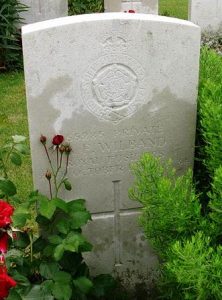
James Edward Somerville Woodman, DSO, MiD, Major, Lancashire Fusiliers. James was born at Clifton, Bristol on 7 September 1870, the son of Commander Charles Edward Somerville Woodman, Royal Navy, and of Ellen Mary Woodman (nee Cooke). He was the nephew of Robert Townley Woodman and Mary Skelton Woodman (nee Busfield), of Maescelyn, Crickhowell. James was educated at The Blackheath Proprietary School before being accepted at the Royal Military Academy, Sandhurst. Upon graduating from Sandhurst, he was commissioned into the West India Regiment as 2nd Lieutenant on 7 January 1891, becoming Lieutenant in January 1893, and Captain in January 1898. He served with the West India Regiment in the Ashanti Expedition, 1895-96, and took part in the operations in Sierra Leone, 1898-99, with the Mendiland Expedition. In 1900 he transferred to the 4th Battalion, Lancashire Fusiliers. James married the widowed Elizabeth Victorine Annetta Armitage (nee Wynne-Owen) at Marylebone Parish Church, London on 29 May 1900. He then served in West Africa, 1903-04, and took part in the operations in Bassa Province against the Okpotos. He divorced Elizabeth on the grounds of adultery with Thomas White in 1907. From July 1909 to March 1912, he held the Adjutancy of the King’s Own Malta Regiment of Militia. James embarked for France with the 2nd Battalion, Lancashire Fusiliers on 22 August 1914, and was awarded the DSO (Distinguished Service Order) for gallantry at Le Touquet. He was decorated by the King in France on 2 December 1914. The citation to his award read: ‘Captain James Edward Somerville Woodman, 2nd Battalion, The Lancashire Fusiliers. Commanded three companies of his regiment in attack on Le Touquet, and afterwards commanded the section of defence which included that village.’ He was then promoted Major and took temporary command of the three amalgamated battalions of the decimated Monmouthshire Regiment until being gassed on 2 May 1915 and returned to England for treatment. Upon his recovery, he commanded a detachment of the 3rd Battalion, Lancashire Fusiliers at Withernsea, before being appointed second in command of the 12th Battalion, Northumberland Fusiliers. The battalion was attached to 62 Brigade, 21st Division and embarked for France at Folkestone on 9 September 1915, disembarking at Boulogne before moving to the Vermelles area, to take part in the forthcoming Battle of Loos. The Division, fresh to the Western Front and very inexperienced, was thrown into action on the opening day of the battle, on 25 September 1915, and suffered terrible casualties in and around the ruins of Loos. On the following day, 26 September 1915, the 12th Northumberland Fusiliers received orders to take the German trenches facing them on Hill 70. James led the charge of the battalion that morning and reached the foot of the hill. As he was raising his binoculars to gain a better view of what his men were facing, he was shot through the heart and fell dead. His battalion was relieved on the following day and moved out of the area, whilst Hill 70 was fought over by the Guards Division over the coming days. The 45-year-old has no known grave and is commemorated on the Loos Memorial, France. James was also Mentioned in Despatches twice, and the notices of his mentions were published in the London Gazette editions of 4 December 1914 and 17 February 1915.
World War Two, 1939-1945
William Douglas Vernon Cable, Pilot Officer, 169109, Royal Air Force Volunteer Reserve. William was the son of Stanley Samuel Cable and Elsie Cable (nee Morgan), of 28, Salmons Villa, Crickhowell. He enlisted into the Royal Air Force Volunteer Reserve and after training as a pilot was posted to 76 Squadron, Royal Air Force. The squadron was based at RAF Holme-upon-Spalding Moor and was a heavy bomber unit, equipped with the Handley Page Halifax. On the night of 20 December 1943 William took off from Holme-Upon-Spalding Moor aboard Handley Page Halifax V, Serial LK732, which formed part of a large group of 650 aircraft despatched to destroy targets in Frankfurt. William was killed when his Halifax was shot down by a night-fighter and crashed at Dachsenhausen, Germany that night. Four of his crew managed to safely bail out of the stricken aircraft as it fell to the ground. The 22-year-old was originally buried besides his two fellow crewmen who died with him in Dachsenhausen Civilian Cemetery, but in May 1947 the three men were re-interred in Rheinberg War Cemetery, Germany.
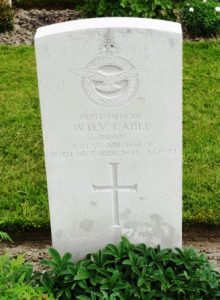
Leonard John Clatworthy, Lance Sergeant, 4192312, Royal Welch Fusiliers. Leonard was the son of Samuel John Clatworthy and Ada Bertha Clatworthy (nee Watkins), of Dardy, Crickhowell. He enlisted into the army and was posted to the Far East with the 2nd Battalion, Royal Welch Fusiliers. The Battalion was part of 29th Independent Infantry Brigade and in 1942, it fought in the Battle of Madagascar, before being transferred to the South-East Asian Theatre. In 1944, the battalion and brigade became part of 36th British Infantry Division, previously an Indian Army formation, and took part in the arduous Burma campaign. Leonard was killed in Burma on 25 October 1944. The 30-year-old was originally buried in Sahmaw Christian Cemetery, but in June 1954 the war graves within the cemetery were exhumed and re-interred in Taukkyan War Cemetery, Myanmar.
Henry Ernest Herbert, Sergeant, 1822275, Royal Air Force Volunteer Reserve. Henry was the son of Tom Joseph Herbert and Margaret Jessie Herbert (nee Pryce), of Crickhowell. He enlisted into the Royal Air Force Volunteer Reserve and trained as a Flight Engineer before being posted to No. 5 Lancaster Finishing School at RAF Syerston, in Nottinghamshire, to complete his training. On 14 April 1944, Henry took off from Syerston aboard Avro Lancaster I, Serial W4103, on a training exercise. The Lancaster collided with an Airspeed Oxford I, of 1521 Flight Training School and both aircraft crashed to the ground near the airfield, killing all crew of both aircraft. Henry was just 19 years old when he was killed that day. He was buried in Oxford (Botley) Cemetery. Henry is not commemorated on the Crickhowell war memorial.
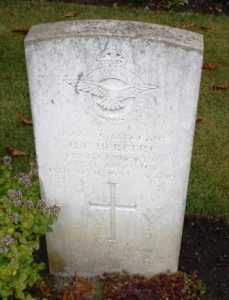
Thomas David Lloyd, Sergeant, 2212943, Royal Air Force Volunteer Reserve. Thomas was the son of John Thomas Lloyd and Mary Amelia Lloyd, of 1, Lower Lodge, Dany Park, Crickhowell. He enlisted into the Royal Air Force Volunteer reserve at some time prior to the end of the war, but remained in the service after the armistice, Thomas was stationed at RAF Kirkham, in Lancashire and was attached to No. 10 School of Technical Training when he married his wife, Mary Lloyd. On 14 May 1947 Thomas was driving an RAF truck through Preston when it skidded on the wet road surface and overturned. Thomas was killed as he tried to leap clear of the vehicle. The body of the 21-year-old was returned home, and he was buried in St. Cattwg’s Churchyard, Llangattock. Thomas is not commemorated on the Crickhowell war memorial.
Rupert Gordon Conrad Lochner, Lieutenant, 343334, Somerset Light Infantry. Rupert was born on 7 February 1925, the son of Major General Rupert Gordon Lochner and Valerie Maud Lochner (nee Grey), of Ty Gwyn, Crickhowell. He was educated at Sherborne School prior to gaining a commission as Second Lieutenant into the Somerset Light Infantry. Rupert was then attached to the 17th Dogra Regiment, Indian Army and served in the Far East during his time at war. He went missing, believed drowned, in Ceylon on 10 June 1945, aged 20. The 20-year-old has no known grave and is commemorated on the Rangoon Memorial, Myanmar. Rupert is not commemorated on the Crickhowell war memorial.
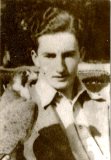
William Marshall, Major, 45211, Royal Army Pay Corps. William was the son of Benjamin and Jane Marshall, of Leeds. William became a bank manager and lived in Leeds with his wife, Alice Beatrice Marshall prior to World War One. He would have served in the army during the war and at some time after returning home the couple moved to 17, Pencommin, Llangynidr, Crickhowell. William was commissioned into the Army Pay Corps following the outbreak of World War Two and was granted the rank of Major. He died on active service in Manchester on 22 December 1941, aged 55. His body was brought back home, and he was buried in Crickhowell Cemetery. William does not appear to be commemorated on any local war memorial.
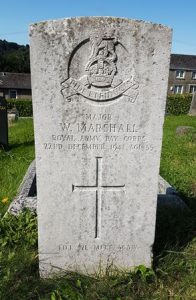
John Rees Morgan, Able Seaman, D/JX 230394, Royal Navy. John was born on 18 July 1920, the son of Howell Rees Morgan and Mabel Elizabeth Morgan (nee Watkins), of the Beaufort Hotel, Crickhowell. He enlisted into the Royal Navy and was posted aboard the brand-new Dido-class cruiser HMS Charybdis. She had completed her sea trials in December 1941, joining the Home Fleet and took part in her first operations during a minelaying sortie that month. In April 1942 she was assigned to join Force H, at Gibraltar, and sailed for there as an escort for the aircraft carrier USS Wasp and battlecruiser HMS Renown. She continued carrier escort work over the coming months, taking part in a number of vital operations around the Mediterranean and in the Atlantic before returning to Britain for a refit in December 1942. She then joined the Home Fleet at Scapa Flow before being transferred to the Plymouth Command, taking part in escort duties again before returning to the Mediterranean for convoy escort duties, escorting General Eisenhower to Salerno. Charybdis then returned to the Atlantic and began operations in the Bay of Biscay. In October 1943 she joined an operation to hunt for the German blockade runner Münsterland, which was carrying an important cargo of latex and strategic metals. Charybdis joined the remainder of the fleet assembled for the hunt on 23 October 1943 but soon afterwards was attacked by two German MTB’s which fired off six torpedoes at her, two of which scored direct hits and exploded on her port side. Charybdis sank within half an hour, with the loss of over 400 men including her captain. John was 23 years old when he died in the sinking of Charybdis that day. His body was later washed ashore on Guernsey, and he was buried in Foulon Cemetery, St. Peter’s Port.
Sakhi Muhammad, Lance Nail, 178590, Royal Indian Army Service Corps. Sakhi was the son of Dost Muhammad and Karam Noor, of Mang, Poonch, Kashmir. He served in the Indian Army with the 32nd Mule Company, Royal Indian Army Service Corps and had probably been in France with the BEF prior to the evacuation from Dunkirk in May 1940. Sakhi died on 2 May 1943 aged 24 and was buried in Crickhowell Cemetery. He is not commemorated on any local war memorial.
Bertram David Shepperson, Flight Sergeant, 561926, Royal Air Force. Bertram was born on 1 March 1912, the son of Bertram Egerton Shepperson, a former South African soldier, and Florence Amy Shepperson (nee Rumsey), of Usk View, Crickhowell. His father died in 1922 and his mother had to raise Bertram, his brother and his sister alone. Bertram enlisted into the Royal Air Force on 1 November 1930 and by the time war broke out was serving as an Observer with 51 Squadron, Royal Air Force, which was based at RAF Dishforth, in Yorkshire. Bertram married Doris Elizabeth Whittle, a native of South Africa, whilst on leave in London in the summer of 1939. The squadron took part in the very first raid of the war, when it dropped propaganda leaflets over Germany on the very first night of the war, using its Armstrong Whitworth Whitley aircraft. On 19 March 1940 Bertram took off from Dishforth aboard Armstrong Whitworth Whitley V, Serial N1405 ordered to bomb the strategic target of the Hornum seaplane base, at Sylt. Bertram was killed when his Whitley was hit by flak whilst over the target area and crashed into the sea off northern Sylt, with the loss of all her crew. Sadly, it was the first of many RAF losses whilst attacking a German land target during the war. Bertram was 28 years old when he died during the crash. He has no known grave and is commemorated on the Runnymede Memorial, Surrey.
Louis David Steylaerts, Flight Sergeant, 152408, Royal Air Force Volunteer Reserve. Louis was born in Antwerp, Belgium on 28 July 1923. He possibly came to Britain as a refugee following the fall of Europe to the Germans in 1940 and came to live at Danygarth, Llangattock. Louis enlisted into the Royal Air Force Volunteer Reserve and trained as a pilot before being posted to 106 Squadron, Royal Air Force, which was based at RAF Metheringham, in Lincolnshire. On the night of 7 May 1944 Louis took off from Metheringham as co-pilot of Avro Lancaster I, Serial LL891, which joined a large force of bombers despatched to destroy the Salbriz explosives and ammunition factory. Louis was killed alongside his entire crew when their Lancaster was shot down over Southern France on the following morning, 8 May 1944 and crashed at Loreaux, near Romorantin Lanthenay. The 20-year-old is buried alongside his crew in Orleans Main Cemetery, France.
John Vincent Webb, Private, 13045946, Pioneer Corps. John was the son of James and Amy Louisa Webb (nee Cooper), of Old Turn Pike, Crickhowell. He married Phyllis Gwendoline Jones at Crickhowell in 1938 and the couple lived at 6, Silver Street in the village. John enlisted into the Royal Engineers soon after the outbreak of war and was attached to the Auxiliary Militia, Pioneer Corps. John was posted to London during the height of the Blitz and was killed during an air raid when a bomb fell near a school at South Ockendon, Essex on 25 October 1940. The body of the 26-year-old was brought home and he was buried in Crickhowell Cemetery.
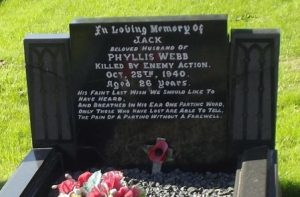
Iraq War, 2003
David Rhys Williams, Flight Lieutenant, 5206526F, Royal Air Force. David was born on 20 June 1965. He joined the Royal Air Force and was posted to 9 Squadron, Royal Air Force, based at RAF Marham. David was posted on operations to the Middle East during the Iraq War. On 22 March 2003 he was flying an RAF GR4 Tornado near the Kuwait border when his aircraft was hit by a US Patriot missile, killing David and his Pilot, Flight Lieutenant Kevin Barry Main. David was 37 years old when he was killed in the ‘Friendly Fire’ incident. The US troops involved initially blamed the tragic incident as an issue with the Tornado itself, but flaws were later fund in the Patriot missile system which led to them mistakenly identifying friendly aircraft as enemy tactical ballistic missiles.